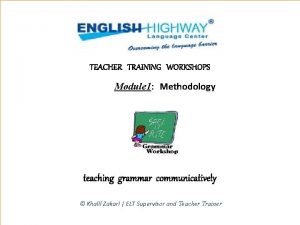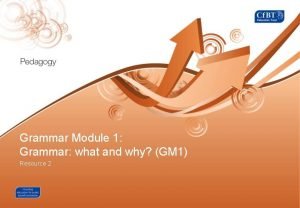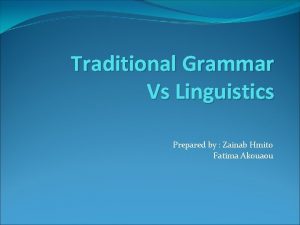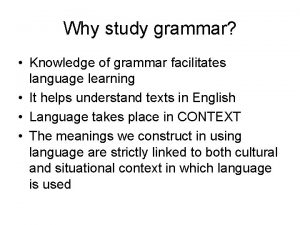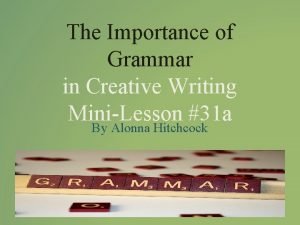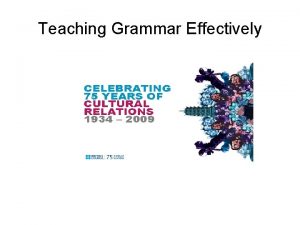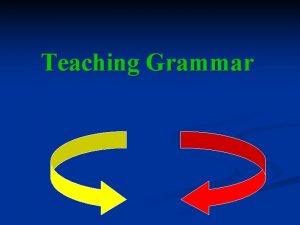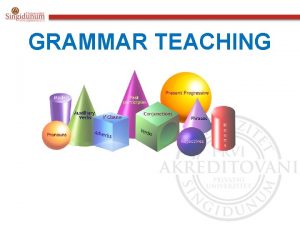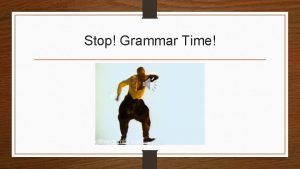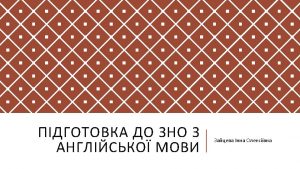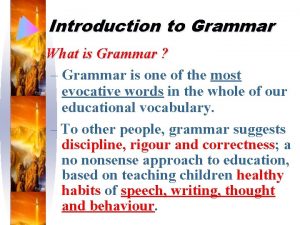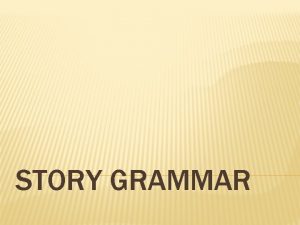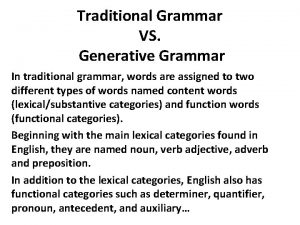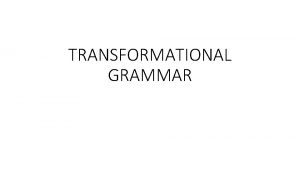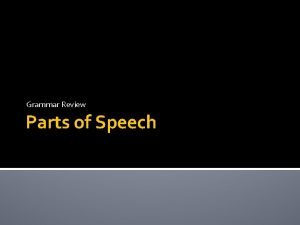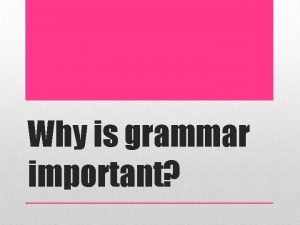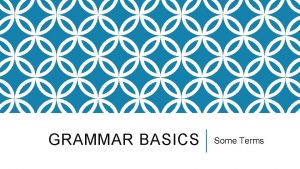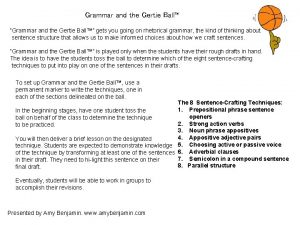Grammar Module 1 Grammar what and why GM




















- Slides: 20

Grammar Module 1: Grammar: what and why? (GM 1) Resource 2

GM 1 2 Grammar Module 1: Grammar: what and why? Definitions • The study of how words and their component parts combine to form sentences (source: http: //www. thefreedictionary. com/grammar) • The system and structure of a language or of languages in general, usually taken as consisting of syntax and morphology (including inflections) and sometimes also phonology and semantics (source: http: //oxforddictionaries. com/definitions/grammar) Produced by Cf. BT Education Trust on behalf of the Department for Education © Crown copyright 2012 2

GM 1 2 Grammar Module 1: Grammar: what and why? Technical definitions of grammar • Descriptive grammar (De Saussure, Bloomfield, early 20 th century) The systematic study and description of a language as used by native speakers. Not related to meaning • Generative grammar (Chomsky, mid-late 20 th century) A set of statements or ‘rules’ which specify which statements in a language are possible and which impossible. Produced by Cf. BT Education Trust on behalf of the Department for Education © Crown copyright 2012 3

GM 1 2 Grammar Module 1: Grammar: what and why? • Transformational grammar A system of grammatical analysis, based on generative grammar, that recognises the existence of deep structure and surface structure, using a set of transformational rules to derive surface structure forms from deep structure. http: //dictionary. reference. com (adapted) Produced by Cf. BT Education Trust on behalf of the Department for Education © Crown copyright 2012 4

GM 1 2 Grammar Module 1: Grammar: what and why? Deep and surface structure The boy saw the man with the telescope Produced by Cf. BT Education Trust on behalf of the Department for Education © Crown copyright 2012 5

GM 1 2 Grammar Module 1: Grammar: what and why? Produced by Cf. BT Education Trust on behalf of the Department for Education © Crown copyright 2012 6

GM 1 2 Grammar Module 1: Grammar: what and why? Produced by Cf. BT Education Trust on behalf of the Department for Education © Crown copyright 2012 7

GM 1 2 Grammar Module 1: Grammar: what and why? Language teachers. . . • Prescriptive grammar A set of rules and examples dealing with the syntax and word structures of a language, usually intended as an aid to the learning of that language. Prescriptive grammar refers to the structure of a language as certain people think it should be used. http: //grammar. about. com Produced by Cf. BT Education Trust on behalf of the Department for Education © Crown copyright 2012 8

GM 1 2 Grammar Module 1: Grammar: what and why? The music of grammar • Can learning grammar be likened to learning to play the piano? • • What are the similarities? What is the end goal of learning to play the piano? Is it about competence or performance? Is any of this relevant to MFL teaching? Produced by Cf. BT Education Trust on behalf of the Department for Education © Crown copyright 2012 9

GM 1 2 Grammar Module 1: Grammar: what and why? ‘Grammar is the structural foundation of our ability to express ourselves. The more we are aware of how it works, the more we can monitor the meaning and effectiveness of the way we and others use language. It can help foster precision, detect ambiguity, and exploit the richness of expression available in English. And it can help everyone – not only teachers of English, but teachers of anything, for all teaching is ultimately a matter of getting to grips with meaning. ’ (David Crystal, in ‘Word and Deed’, TES Teacher, 30 April 2004) Produced by Cf. BT Education Trust on behalf of the Department for Education © Crown copyright 2012 10

GM 1 2 Grammar Module 1: Grammar: what and why? Why does grammar matter? Produced by Cf. BT Education Trust on behalf of the Department for Education © Crown copyright 2012 11

GM 1 2 Grammar Module 1: Grammar: what and why? Why does grammar matter? • To clarify meaning, e. g. in verbs: – Whether action is past, present or future (although not always dependent on verb) – Who was responsible – Who was the recipient of the action – Whether it happened just once or repeatedly Produced by Cf. BT Education Trust on behalf of the Department for Education © Crown copyright 2012 12

GM 1 2 Grammar Module 1: Grammar: what and why? Why does grammar matter? (continued) • To avoid ambiguity (e. g. agreement) • To aid clarity of expression • To provide social status (education) • To enhance stylistic effect Produced by Cf. BT Education Trust on behalf of the Department for Education © Crown copyright 2012 13

GM 1 2 Grammar Module 1: Grammar: what and why? Is there any difference between L 1 and L 2 in terms of the importance of grammar? • How much tolerance of error should there be in L 2? • Is communication all that matters? • Competence or performance? • Are the rules different in speaking and writing? • How important is social meaning in L 2? • Is the aim to sound as close as possible to a native speaker? Produced by Cf. BT Education Trust on behalf of the Department for Education © Crown copyright 2012 14

GM 1 2 Grammar Module 1: Grammar: what and why? Are some languages easier to learn than others? ‘He that understands grammar in one language understands it in another as far as the essential properties of Grammar are concerned’ (Roger Bacon) Produced by Cf. BT Education Trust on behalf of the Department for Education © Crown copyright 2012 15

GM 1 2 Grammar Module 1: Grammar: what and why? Contrastive linguistics • Looks at comparisons between languages to find dissimilarities (e. g. … ) • Linguistic typology – genetic similarities, implicational universals etc. • Useful to predict where learners might have difficulties • Usually in areas where L 1 and L 2 are different Produced by Cf. BT Education Trust on behalf of the Department for Education © Crown copyright 2012 16

GM 1 2 Grammar Module 1: Grammar: what and why? • Word order (SVO, VSO or SOV) The cat ate the mouse (English) Ate the cat the mouse (Welsh) The cat the mouse ate (Turkish) • Case • Tense • Mood • Gender • Politeness • Affective factors (empathy, connotations, motivation etc) Produced by Cf. BT Education Trust on behalf of the Department for Education © Crown copyright 2012 17

GM 1 2 Grammar Module 1: Grammar: what and why? • Which of these factors are relevant to French / German / Spanish? • Should this affect what we offer students? • Can this understanding help our teaching? Produced by Cf. BT Education Trust on behalf of the Department for Education © Crown copyright 2012 18

GM 1 2 Grammar Module 1: Grammar: what and why? KAL and LLS – KS 2 framework Year 6 Children become more confident users of language, reflecting on their knowledge about language and using this to make meanings that matter to them. They develop greater independence in applying language learning strategies and in transferring language from one context to another. Produced by Cf. BT Education Trust on behalf of the Department for Education © Crown copyright 2012 19

GM 1 2 Grammar Module 1: Grammar: what and why? Intercultural Understanding – KS 2 framework Year 6 • Children compare attitudes of different cultures. • They discuss stereotypes and reflect on the importance of developing tolerance and understanding between people. • They celebrate their understanding and knowledge with others. Produced by Cf. BT Education Trust on behalf of the Department for Education © Crown copyright 2012 20
 Pictures
Pictures Dont ask why why why
Dont ask why why why Teaching and assessment of grammar module 1
Teaching and assessment of grammar module 1 C device module module 1
C device module module 1 Right linear to left linear grammar
Right linear to left linear grammar Grammar module
Grammar module Strengths and weaknesses of traditional grammar
Strengths and weaknesses of traditional grammar Chomsky hierarchy of grammars
Chomsky hierarchy of grammars Right linear grammar to left linear grammar
Right linear grammar to left linear grammar Language
Language 10 reasons why grammar is important
10 reasons why grammar is important Alternative times
Alternative times Module 5 supply and demand introduction and demand
Module 5 supply and demand introduction and demand Why-why analysis
Why-why analysis Willie twister
Willie twister Does the table represent a function why or why not
Does the table represent a function why or why not What does the image represent
What does the image represent Why or why not
Why or why not Contoh root cause analysis 5 why
Contoh root cause analysis 5 why A graphic language and has its own alphabet and grammar
A graphic language and has its own alphabet and grammar Why are most roadways crowned
Why are most roadways crowned


